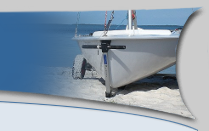Overview:
The JY15 performs best to a certain sailing style: boat flat and footing, sails eased, and the rig raked. To understand why this style is fast, first you need to take a look at some of the distinctive features of the JY rig.
The JY15 has a smallish centerboard. Because of this:
If you heel the boat upwind, the centerboard is less effective. You must sail the boat flat especially in a breeze. For a small centerboard to be effective, you must get water flowing over it. You need to ease the mainsail and foot; you must keep the boat moving fast. If you try to pinch, not only will you be moving slower, but your leeway will increase as well.
The JY15 does not have an adjustable traveler. Because of this:
The traveler is always centered. Also, the mainsheet has 3:1 purchase. These factors make it very easy to over trim the mainsail. You have to keep the sheet eased and the boom at least halfway between the centerline and the leeward quarter. Otherwise, you cannot foot the boat and you will be forced to pinch which will tend to stall the centerboard.
Since you can’t trim the mainsail hard, the only way to control forestay sad as the wind increases is by tightening the shrouds and adjusting the mast chocks.
Sailing the boat “loose and level” leaves the helm feeling “mushy.”
Very slight weather helm is fast when sailing to weather because it means the rudder is generating lift. But you cannot get weather helm by heeling the boat or over trimming the mainsail because this had been proven to be slow.
The best way to generate a slight weather helm is to sail with as much rake as possible. This is why you set your head stay as long as possible.
Traveler
Check the length of your traveler. The length of the rope, before knots are put in it, should be the maximum allowed 48”. This raises the height of your traveler and allows you to sheet the sail without as much leech tension. This is important for light air speed.
Main Halyard Tension
Lead the main halyard down the front of the mast so that the halyard is forward and inside the shroud. This minimizes the tendency for the halyard to go slack as the mast bends. Mark the halyard and put a scale on the side of the mast. The total tension range is 3” with the tension gradually increasing as the wind builds. Set the halyard so that there are small wrinkles in only the lower third of the sail’s luff. A Cunningham may be rigged in case the wind comes up suddenly, but otherwise should not be needed.
Outhaul
Tension the outhaul until a small fold just begins to appear in the bolt rope tape in the foot of the main.
Vang Tension
Put the mainsail up on the shore in calm conditions. Reverse the vang so that the cleat is at the boom. Take all the slack out of the vang, but put no tension on it. From this position in the cleat, make four marks on the tail of the vang. The first mark is 1” from the slack position followed by marks at 3 ½”, 5 ½” and 8”
Setting the Vang:
0-5 knots mark #1
6-10 knots mark #2
11-15 knots mark #3
16 + knots mark #4
Jib Sheet Trim
One advantage of sailing with a lot of rake is that the foot of the jib lays closer to the deck. This provides a better end plate for the sail and makes it more efficient. The extra rake, however, does make the bottom of the jib sheet rather flat. We compensate for this by pulling approximately 2” on the weather sheet in light to medium winds. This deflects the clew of the jib about 1” inboard and adds curvature to the bottom of the sail.
Setting up the JY15
Tuning the rig:
- Set the forestay as long as possible.
- Set the shrouds on the second hole down from the top in the “gross adjuster.”
- Put one chock behind the mast and one in front, and with someone hanging on the main halyard to pull the tip of the mast toward you, attach the shrouds to their deck eyebolts.
- With the forestay lever tensioned, and the boom off the mast center the mast in the partner and sight up the sail track. The mast should be straight sideways. If it isn’t then one shroud is probably longer than the other. Adjust the relative tensions until the mast is straight.
- With this setup, your shrouds should have approximately 250lbs of tension. This is a good all purpose rig setting. If you are not quite at these numbers, try adjusting the fine-tuning holes on your shroud adjusters.
- You can fine-tune the rig for special conditions: light or heavy air. For light air, try loosening the shrouds one diagonal hole on the “fine adjuster,” and putting both partner chocks behind the mast. In heavy air you can tighten the shrouds one diagonal hole from your all-purpose setting, and put both chocks in front of the mast. (In windy, flatter water conditions, try leaving the chocks centered and tighten two “fine” holes.) Although adjusting the shrouds is not recommended while you are out on the water, don’t be afraid to move any chocks, as my adjustment is of benefit.
Basic Rig Settings:
0-10 knots ease shrouds one “fine” hole both chocks behind
5-20 knots shrouds 250 lbs./forestay 100 lbs. chocks centered
15-20 knots tighten shrouds one “fine” hole both chocks ahead
Mainsheet Trim
Tension the compression batten gently, so that there aren’t any significant wrinkles in the sail along the length of the batten. Be careful of over tensioning the batten as this can make the top of the sail too full and the batten to difficult to tack in light winds. Take a piece of dark tape, or a magic marker, and make a dark line to mark the last 12” of the batten pocket’s length. This gives you a trim reference.
When trimming the mainsail, tension the sheet so that this last 12” of the batten are parallel to the boom. You will have to get down under the boom and site up the leech to get a feel for this trim. The sail will look quite twisted to the eye and the top telltale will always stream aft, except in near drifting conditions. If the tip telltale stalls, you are drastically over trimmed. Take your jib sheets and either sew or tie them permanently to the clew of your jib. Mark each sheet at 17 ½,” 19,” 20 ½,” and 52.” Your first three marks are used for reference for primary sheet tension. When these marks become just visible as they pass out of the aft side of the ratchet block, you are at each trim setting.
The fourth mark, at 52,” is used for “weather sheeting.” In light to medium air, take the weather jib sheet, and trimming through the weather ratchet block, tension it so that the mark is centered in the weather cleat.
Jib Sheet Trim
0-5 knots mark #1 add weather sheet tension in 4-10 knots
6-12 knots mark #2
13-17 knots mark #3
18+ knots mark #2
Jib Halyard Trim
Mark the jib halyard and put a scale on the side of the mast. The total range of jib halyard tension is 2”. Set it loose in light air and gradually tension it as the wind increases. Set the halyard so that you just pull out the scallops that appear between the jib luff links.
Reaching
When sailing downwind, keep the weight well forward in the boat. When racing, set the vang to make your 12”batten mark parallel to the boom. Hold the jib sheet by hand to leeward. Position your hand so the sail luffs evenly from top to bottom when the boat is turned into the wind.
Running
When running, ease the vang more, so that the top batten is perpendicular to the wind. Even though the boom is restricted from being let out by the shrouds, you can still “let out” the upper half of the sail by easing the vang. Be careful not to over ease the vang in heavy air, and make sure the crew has a hand on the centerboard, ready to put it down before you lose control in the biggest puffs. Wing the jib to the weather side. In winds under 5 knots, easing the vang will not open the upper leach due to the weight of the sail and the boom. In these conditions, you should not wind the jib, but instead sail on a broad reach with the jib trimmed to leeward, and jibe back and forth to the leeward mark.
Good luck and good sailing with your JY15 and North Sails!
Thanks to Ed Adams for compiling the information for this guide.
Download a PDF version of the JY15 Tuning Guide
Parts List, provided by Hunter Marine
JY15 Line Chart
Repair Guide

